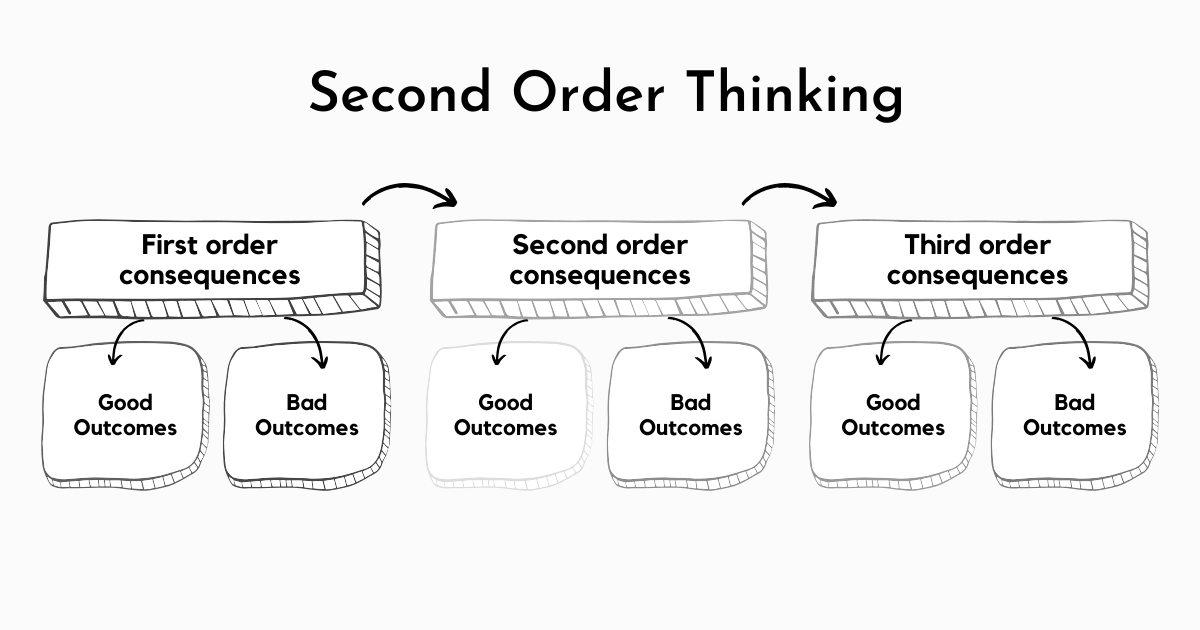Introduction
In the realm of decision-making, Second-Order Thought emerges as a crucial mental model deeply rooted in human psychology. It involves thinking beyond the immediate consequences of our actions and considering the higher-order effects and long-term implications. This mental model plays a pivotal role in guiding rational decision-making by accounting for complexity, interdependencies, and unintended consequences. By understanding the concept of Second-Order Thought, individuals can avoid falling into cognitive traps, make informed choices, and maximize their long-term interests.
Defining Second-Order Thought and Its Relevance
Second-Order Thought is a mental model that encourages individuals to consider the consequences and broader effects of their decisions beyond the immediate impact. It goes beyond first-order thinking, which focuses on immediate gains or losses, and delves into the complexities and ripple effects of actions. By incorporating Second-Order Thought, individuals can make decisions that align with their long-term goals, account for externalities, and avoid short-sightedness.
This mental model is prevalent in our day-to-day lives, influencing personal decisions, business strategies, and public policy-making. By adopting Second-Order Thought, individuals can avoid making impulsive choices, businesses can plan for sustainability and adaptability, and policymakers can consider the wider societal implications of their decisions.
Examples of Second-Order Thought in Various Contexts
- Personal Life Decisions: Consider an individual deciding whether to purchase an expensive luxury item. Second-Order Thought prompts them to consider the long-term financial implications, such as potential debt or reduced savings for future goals. By considering the opportunity costs and broader financial impact, individuals can make more rational decisions aligned with their financial well-being. Without Second-Order Thought, individuals might succumb to immediate gratification and overlook the long-term consequences.
- Business Scenarios: In the business world, Second-Order Thought is crucial for strategic planning. For example, a company considering a cost-cutting measure such as layoffs must weigh the potential short-term savings against the long-term effects on employee morale, productivity, and company reputation. By adopting Second-Order Thought, businesses can avoid damaging their organizational culture and customer relationships in pursuit of short-term gains.
- Public Policy-Making: Second-Order Thought plays a significant role in public policy-making. Policymakers must consider not only the immediate effects of their decisions but also the long-term implications for society. For instance, when implementing environmental policies, they must consider the potential impact on job creation, economic growth, and public health. By employing Second-Order Thought, policymakers can develop comprehensive and sustainable policies that address both short-term needs and long-term well-being.
Mental Biases and Psychological Underpinnings
Several cognitive biases can hinder Second-Order Thought. One such bias is the Present Bias, where individuals prioritize immediate rewards over long-term benefits. This bias can lead to decisions that neglect the long-term consequences, as individuals focus solely on instant gratification.
Another bias is the Status Quo Bias, which favors maintaining the current state of affairs due to familiarity and aversion to change. This bias can impede Second-Order Thought by preventing individuals from critically evaluating and considering alternative options with potentially better long-term outcomes.
Moreover, the Confirmation Bias, where individuals seek information that confirms their existing beliefs, can hinder Second-Order Thought by limiting the scope of information considered and potentially disregarding alternative perspectives and potential consequences.
Practical Strategies for Identifying and Avoiding Second-Order Thought
To enhance Second-Order Thought and avoid the associated cognitive biases, consider the following strategies:
- Embrace Systems Thinking: Adopt a holistic perspective that considers the interconnectedness of various factors and their long-term implications. Develop an understanding of the complex systems and interdependencies involved in decision-making.
- Conduct Scenario Analysis: Evaluate different scenarios and their potential outcomes by considering various factors and their potential interactions. This helps identify potential second and third-order effects and enables more informed decision-making.
- Seek Diverse Perspectives: Actively seek out diverse viewpoints and opinions, encouraging critical thinking and challenging assumptions. Engage in constructive dialogue and consider alternative perspectives to overcome confirmation bias and broaden your understanding.
- Conduct Cost-Benefit Analysis: Assess the long-term costs and benefits of different options. Consider not only immediate gains or losses but also potential future consequences and trade-offs associated with each choice.
Conclusion
Second-Order Thought empowers individuals to make rational decisions by considering the broader effects and long-term implications of their actions. By embracing this mental model, individuals can avoid short-sightedness, navigate complexity, and optimize decision-making. Awareness of the cognitive biases that hinder Second-Order Thought is vital for making more informed choices. By incorporating practical strategies such as systems thinking, scenario analysis, and seeking diverse perspectives, individuals can enhance their ability to think beyond immediate outcomes and make decisions that align with their long-term goals and best interests. The value of Second-Order Thought lies in its ability to guide individuals towards sustainable, thoughtful, and strategic decision-making.
